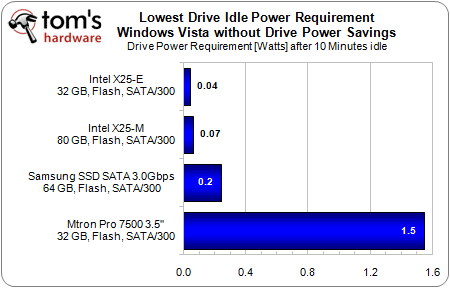Intel’s X25-E SSD Walks All Over The Competition
Client Application Performance And Power Consumption
The PCMark05 benchmarks certainly aren’t the best tool to evaluate business SSDs such as the X25-E, but they show how this drive would do in a high-end desktop PC.
When it comes to writing files sequentially onto a formatted drive, the X25-E does very well, but it doesn’t beat Seagate’s Cheetah 15K.6. As already mentioned, hard drives are still a great choice if you need high performance streaming performance for audio/video editing and similar applications.
The Windows XP startup benchmark requires both high throughput and quick access time, as it simulates the data that is accessed by Windows XP when booting up. The Intel SSDs clearly dominate here, and the difference between the X25-E and the X25-M is small enough to make the X25-M the better choice for desktops (since it offers 80 GB instead of 32 GB, at a lower price).
Power Consumption
We test power consumption by running specific workloads, as this is typically more relevant than the usual idle and peak power consumption numbers. The first test is DVD playback, which requires a constant and limited stream of data. Our second test checks the lowest idle power requirement. Finally, we check efficiency for workstation use and streaming read workloads.
We don’t have results for all of the drives we used for comparison, as the test system is a notebook that wouldn’t allow us to attach the SAS hard drives. However, pretty much every 2.5” hard drive is above 1 W for this test, which tests the drives’ power consumption when delivering a rather small, but constant stream of data. Both 15,000 RPM hard drives by Hitachi and Seagate require more than 10 W idle power, as they were never designed to be efficient at such a workload. Intel’s X25 SSDs do well, but the power-optimized Samsung 64 GB Flash SSD is the most efficient.
We had the test system running idle for 10 minutes before we tracked idle power, as we wanted to see if the drives switched to a low-power idle mode. The results for the Intel SSDs are exciting: if they idle, they effectively don’t consume any power at all: 0.04 W for the X25-E and 0.07 W for the X25-M at extended idle pretty much speak for themselves.
Get Tom's Hardware's best news and in-depth reviews, straight to your inbox.
Current page: Client Application Performance And Power Consumption
Prev Page I/O Performance, Access Time Next Page Workstation I/O Efficiency


